Conservationist Recipes
Alligator
Louisiana Alligator Creole Stew
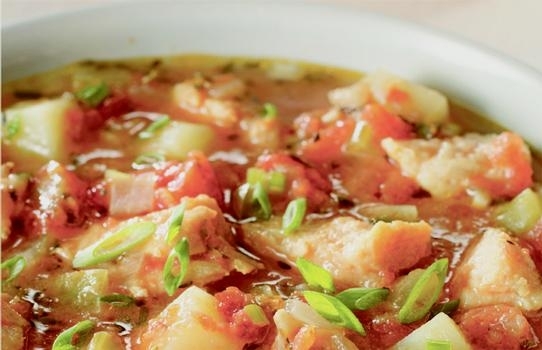
Courtesy of the Louisiana Seafood Promotion & Marketing Board
Yields six entree portions
- 2 lbs. Louisiana alligator, cut into 1-inch cubes
- 1 Tbsp. canola oil
- 2 Tbsp. garlic, minced
- 1 cup onions, small dice
- ¾ cup green bell peppers, small dice
- ½ cup celery, small dice
- ½ cup white wine
- 3 cups chicken stock
- 24 oz. can diced tomatoes
- 1-½ cups potatoes, medium dice
- 1 Tbsp. dried thyme
- 1 Tbsp. dried oregano
- 1 bay leaf
- 1/8 tsp. cayenne
- 2 tsp. Original TABASCO® Brand Pepper Sauce
- 1 tsp. Worcestershire sauce
- Salt to taste
- Pepper to taste
- ¼ lb. butter
- 1 cup green onions, chopped
- 1 baguette, sliced and toasted
Heat canola oil in 8-quart stock pot over medium-high heat. Add garlic, onions, green peppers and celery. Cook for 6-8 minutes, until onions are translucent and vegetables are tender.
Add white wine, chicken stock, tomatoes, thyme, oregano, bay leaf, cayenne, Tabasco® and Worcestershire. Season to taste with salt and pepper. Bring to simmer and cook for 5 minutes.
Add Louisiana alligator cubes to stew. Cover and simmer for 45 minutes. Add butter and green onions to stew and stir until butter melts. Remove bay leaf.
Serve with sliced, toasted baguette.
Louisiana Alligator Tenderloin Scaloppini with Lemon Caper Sauce
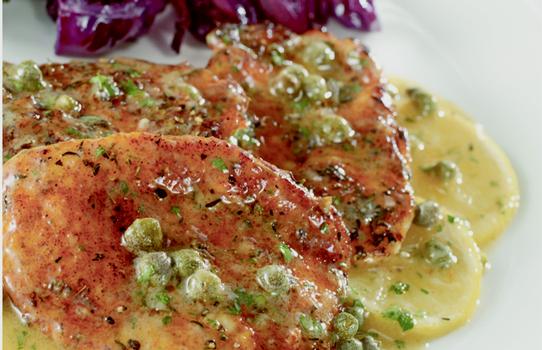
Courtesy of the Louisiana Seafood Promotion & Marketing Board
Yields four entrée portions
- 8 Louisiana alligator tenderloin, ¼-inch-thick slices, 2 oz. each
- 1 Tbsp. paprika
- 1 tsp. cayenne
- 2 tsp. thyme, dried
- 1 tsp. oregano, dried
- 1 Tbsp. garlic powder
- 1 Tbsp. onion powder
- 2 tsp. white pepper, ground
- 2 tsp. black pepper, ground
- 2 tsp. salt
- 1 cup flour
- 3 Tbsp. canola oil
- ½ cup white wine
- ½ cup chicken stock
- 2 Tbsp. lemon juice
- 2 Tbsp. capers, chopped
- ¼ lb. butter, unsalted, ½-inch cubes
- 2 Tbsp. parsley, chopped
- Salt to taste
- Pepper to taste
Combine paprika, cayenne, thyme, oregano, garlic powder, onion powder, white pepper, 2 tsp. black pepper, and 2 tsp. salt. Set aside.
Place one piece Louisiana alligator between two pieces of plastic wrap. Pound with mallet to tenderize. Repeat with remaining pieces.
Season tenderloin on both sides with spice mixture. Dredge in flour and shake off excess flour.
Heat canola oil in large skillet over medium-high heat. When oil begins to shimmer, add seasoned tenderloin. Cook until edges start to brown (about 3 minutes) and then flip over to cook other side for additional 2-3 minutes.
Remove tenderloin from pan and set aside. Add white wine and chicken stock to pan and cook over medium-high heat until volume is reduced by a third. Add lemon juice, capers, and butter, swirling pan until butter melts completely. Season to taste with salt and pepper. Return tenderloin to pan and coat with sauce. Simmer for additional 8-10 minutes.
Serve scaloppini with lemon caper sauce spooned over top.
Duck
Duck Poppers
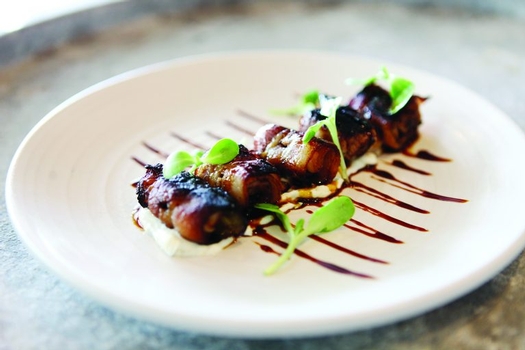
Courtesy of Chef Brian Landry
Yields 16 duck poppers
- 1-½ pounds duck breasts, skin removed and cut into 16 strips, about ¼ inches thick and 2 inches wide
- Salt and pepper
- 1 Tbsp. chopped fresh thyme
- 1 Tbsp. chopped fresh parsley
- Big pinch cayenne pepper
- ½ cup Creole or regular cream cheese, softened
- 16 slices pickled jalapeño
- 8 strips thick-cut smoked bacon, halved and blanched
Preheat the broiler. Season the duck strips with salt and pepper and lay out on a platter. In a bowl, mix the thyme, parsley, and cayenne into the softened cream cheese; add salt and pepper. Put a slice of jalapeño on each duck strip, then spoon on ½ tablespoon of seasoned cream cheese. Wrap each strip around the filling, then wrap a piece of bacon around the duck. Secure the poppers on skewers.
Broil the skewers until the bacon is crispy and slightly charred, turning once. Serve immediately. Recommend to pair with cane syrup sherry vinegar gastrique.
“This dish is a fishing camp favorite! We always have frozen wild duck in the freezer at the camp, so we just add a little jalapeno to the center and wrap it up in bacon. My buddy Drew Mire makes the most delicious blackberry old fashioned to wash it all down. Now that is some good late night snacking!”
–Chef Brian Landry
Fish
Grilled Redfish and Crabment with Lemon Butter Sauce
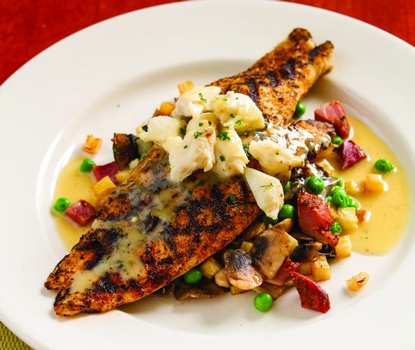
Courtesy of Chef Austin Kirzner
Yields six servings
- 1 recipe lemon butter sauce
- Salad oil (not olive oil) for brushing on the grill rack and fish fillets
- ¼ cup good-quality dry white wine, divided, plus a few tablespoons of the wine if grilling the fillets in batches
- 6 skinless redfish fillets, 6 to 8 ounces each, neatly trimmed, with the belly removed if it is still attached
- 2 Tbsp. Creole seasoning
- 4 Tbsp. unsalted butter
- 1 pound jumbo lump crabmeat, picked through
- 1 tsp. kosher salt
- 1 tsp. freshly ground black pepper
- Warm French bread, for the table
Clean the grill rack with a wire brush and preheat it until it is hot. Then add wet or dry hickory or other wood chips. Brush the rack with a thick wad of paper towels saturated in salad oil, holding the paper towels with long-handled tongs so you don’t burn yourself.
While the grill is preheating, prepare the lemon butter sauce if this is not already done, and keep it warm as directed in the sauce recipe.
Place the fillets on a work surface. Brush both sides with salad oil, and season each fillet evenly on both sides with Creole seasoning, using ½ teaspoon of the seasoning on each side of each fillet.
Once the grill is ready, place the fillets directly on it and cook until they are done, about 2-½ to 4 minutes per side. The cooking time will vary according to the heat of the grill and the thickness of the fillets. (Watch closely so the fish does not overcook.) Use a broad, large and sturdy spatula to turn over the fillets at least once while cooking.
When you think the fish is approaching the level of doneness you’re looking for, briefly insert the tip of a knife into the thickest part of the fillet. Then lay the tip of the blade flat against the inside of your wrist. If the tip feels hot against your skin the fish should be done.
If cooking the fillets in batches, transfer them to a heat-proof platter placed in a warm spot, and drizzle the fillets with white wine to keep them moist while grilling the remaining fish.
While the fillets are grilling, sauté the crabmeat. In a heavy 12-inch sauté pan, melt butter over medium-high heat until hot, about 3 minutes. Add ¼ cup wine and heat for 30 seconds. Add the crabmeat and season with 1 teaspoon kosher salt and 1 teaspoon pepper. Cook until the crabmeat is just warmed through, about two minutes, lightly tossing so the lumps of crabmeat stay intact. Serve immediately.
Serving Suggestion: Arrange a fish fillet on each heated dinner plate. Top each with a portion of the crabmeat, and spoon 3 tablespoons of the sauce over it.
Lemon Butter Sauce
- 1½ cups good-quality dry white wine
- ½ cup fresh lemon juice
- ½ tsp. minced or very finely grated lemon zest
- 1 tsp. apple cider vinegar
- 1 tsp. minced shallots
- 1 tsp. minced garlic
- 1 tsp., packed, minced fresh thyme leaves
- 2 Tbsp. heavy cream
- 3½ sticks cold unsalted butter, cut into about 20 pats
- 1 tsp. kosher salt, or to taste
- ¼ tsp. freshly ground black pepper, or to taste
In a heavy, nonreactive 3-quart saucepan, combine the wine, lemon juice and zest, vinegar, shallots, garlic, and thyme. Cook over medium-high heat until the liquid in the mixture reduces to 1 to 2 tablespoons, about five minutes.
Add the cream and cook until the liquid in the pan reduces to 1 to 2 tablespoons, about 4 minutes. (The sauce may be prepared to this point up to 45 minutes ahead and left at room temperature. Reheat the cream mixture briefly over medium heat, whisking constantly, before proceeding to the next step.)
Reduce the heat to medium-low and cook as you add 2 pats of butter at a time, whisking constantly, until all the butter is added and incorporated into the sauce; each addition of butter should be almost completely melted in before adding more. This will take roughly 10 to 15 minutes total. Remove from heat.
Whisk in the kosher salt and pepper. If serving the sauce immediately, strain through a fine-mesh strainer into a small saucepan. If not serving promptly, strain the sauce into the top of a double boiler and serve as soon as possible and definitely within 1 hour, keeping the sauce warm, uncovered, over hot (not simmering) water.
Baked Red Snapper or Redfish with Crabmeat Stuffing
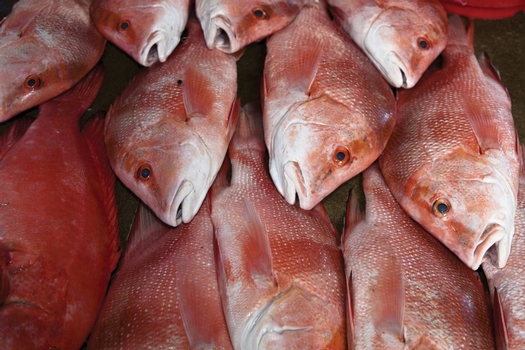
- 5-7 lbs. red snapper or redfish
- 1 lb. shrimp
- 1 large onion, finely chopped
- 2 garlic cloves, minced
- 2 Tbsp. oil
- 6 slices white bread
- 1 green pepper, finely chopped
- 1 Tbsp. parsley, minced
- ½ lb. crabmeat
- 1 Tbsp. celery, chopped
- ¾ tsp. salt
- ¼ tsp. pepper
- 1 cup wine
Preheat oven to 400 degrees. Shell and clean the shrimp and cut into small pieces. Saute the onion and garlic in oil until clear. Add the shrimp and saute for about 10 minutes. Dampen the bread, mash it, and add to onion and shrimp mixture. Add the green pepper, parsley, crabmeat, celery, and seasoning. Simmer for 10 minutes, stirring constantly. Place the stuffing inside the fish and sew up the opening or fasten with skewers.
Place the fish in a greased baking pan. Pour wine over it and bake in preheated oven, with a piece of foil over it for the first 15 to 20 minutes. Remove foil. Dust lightly with flour. Baste from pan occasionally and bake until the flesh flakes to a fork and it crusty brown.
Remove the fish to a heated serving platter and keep warm.
Sauce:
- 1 stick butter
- 2 shallots, finely chopped
- 2 tsp. parsley, minced
- ½ lb. crabmeat
Saute shallots and parsley for a few minutes in melted butter. Add crabmeat and gently stir. Pour over fish and serve immediately.
Oysters
Oysters on the Half Shell with Trio of Mignonette Sauces
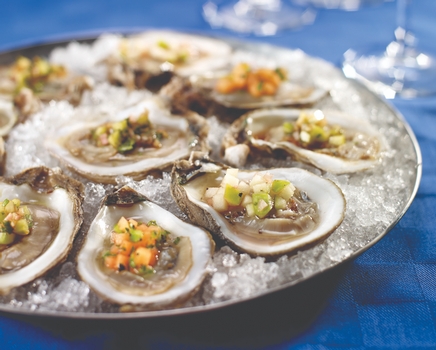
Yields four appetizer portions, six oysters per serving
- 24 Louisiana oysters, cleaned*
Shuck Louisiana oysters and serve over ice. Spoon each oyster with alternating mignonette sauces.
*Use only freshly shucked oysters for this recipe.
Green Apple Mignonette
- ½ cup green apple, small diced
- ¼ cup shallots, minced
- ¾ cup red wine vinegar
- 1 tsp. black pepper, fresh cracked
Combine apples, shallots, red wine vinegar, and black pepper. Refrigerate until well chilled.
Sweet Melon Mignonette
- ½ cup cantaloupe, small diced
- ¾ cup rice vinegar
- 2 Tbsp. jalapeños, minced, no seeds
- 2 tsp. tarragon, chopped
- 1 tsp. black pepper, fresh cracked
Combine cantaloupe, rice vinegar, jalapeños, tarragon, and black pepper. Refrigerate until well chilled.
Cucumber Mignonette
- ¼ cup cucumber, small diced
- ¼ cup shallot, minced
- 2 Tbsp. cilantro, finely chopped
- ¾ cup sherry vinegar
- 1 tsp. black pepper, fresh cracked
Combine cucumbers, shallots, cilantro, sherry vinegar and black pepper. Refrigerate until well chilled.
There may be a risk associated with consuming raw shellfish as is the case with other raw protein products, if you suffer from chronic illness of the liver, stomach, or blood or have other immune disorders, you should eat these products fully cooked.
Parkway's Oyster Bacon Po-Boy
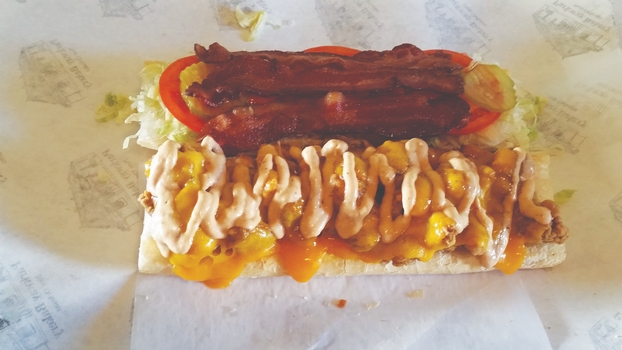
Courtesy of Parkway Bakery
Yields one po-boy
- French bread
- 12 fresh Louisiana oysters
- 3 strips of applewood smoked bacon
- Shredded or sliced cheddar cheese
- Remoulade sauce
- Shredded lettuce
- 3 tomato slices
- Handful of pickles
- Mayo
Toast the French bread in the oven. Put the Louisiana oysters in flour or preferred batter mixture and fry. Dress the French bread with lettuce, pickles, tomato, and mayo. After dressing the bread, pan fry bacon and cook to a light crisp and add to dressed side. Next, take the fried oysters and layer them on the bottom of the bread. Take the cheddar cheese and place on top of the oyster and melt in the oven for just a minute or so. Finish the sandwich off by drizzling remoulade sauce on top of the bacon.
Shrimp
Creole BBQ Shrimp
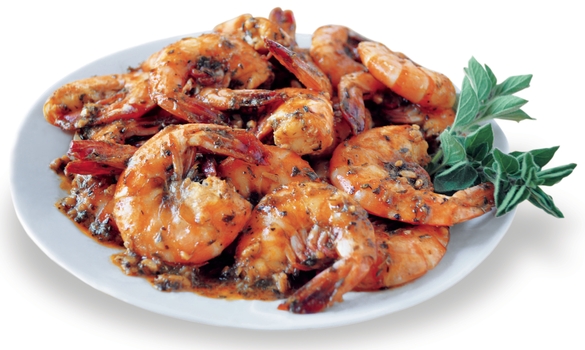
Courtesy of Chef Brian Landry and the Louisiana Seafood Promotion and Marketing Board
Yields four appetizer portions
- 1-½ pounds extra jumbo Louisiana shrimp (16-20 count), peeled and deveined, tail on
- ½ tsp. Kosher salt
- ½ tsp. coarsely ground black pepper
- 1 Tbsp. Creole seasoning
- 1 tsp. powdered garlic
- 2 Tbsp. olive oil
- 3 Tbsp. white wine
- 2 tsp. lemon juice
- 2 tsp. original Tabasco pepper sauce
- 1 tsp. Worcestershire sauce
- 6 Tbsp. unsalted butter, cut into small cubes
- 2 Tbsp. fresh chives, chopped
Combine salt, black pepper, Creole seasoning, and powdered garlic in large bowl. Add Louisiana shrimp to the bowl and toss to coat with seasoning Heat large saute pan over medium-high heat. Add olive oil and shrimp. Saute for 1 to 2 minutes. Add white wine, lemon juice, Tabasco sauce, and Worcestershire sauce and cook additional minute. Add butter to saute pan and swirl until melted. Add chives and remove from heat. Divide shrimp and sauce evenly into four bowls and serve with sliced, toasted baguette.
Venison
Grilled Venison Loin with Horseradish Cream
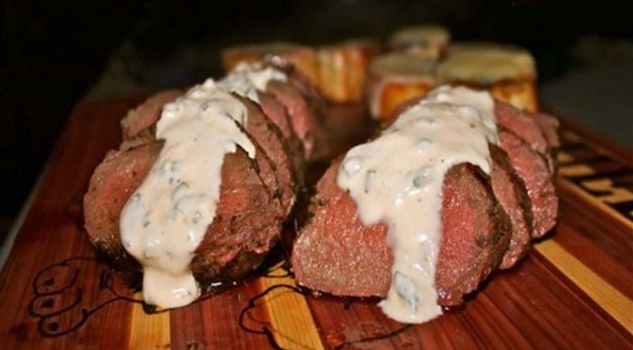
Courtesy of Chef Jesse Griffiths
Serves 4
- 1-½ to 2 pounds venison loin, trimmed of all silverskin
- Kosher salt and freshly ground black pepper
- 2 Tbsp. finely chopped fresh herbs: thyme, marjoram, oregano, rosemary, savory, and/or parsley
- 3 Tbsp. olive oil
- 1 cup creme fraiche or sour cream
- 2 Tbsp. or more freshly grated or prepared horseradish
- 2 tsp. chopped fresh chives or parsley
- Juice and zest of 1 lemon
Season the meat with salt and pepper. In a small bowl, mix the 2 tablespoons herbs with the olive oil and spread all over the meat. Marinate for 2 hours or overnight, refrigerated.
Make a hot, even fire in a charcoal grill, or set a gas grill on high heat.
Grill the meat on one side without moving it until nicely browned, 4 to 5 minutes, then rotate 90 degrees to make grill marks and to char more surface area. Flip the loin, cooking 4 to 5 minutes more. Aim for a good, deeply browned char on the outside but leaving the meat still nice and rare on the inside. Transfer to a warm plate and allow to rest for at least 10 minutes while you prepare the sauce.
For the horseradish sauce, mix the creme fraiche, horseradish, chives, lemon juice, and zest together in a small bowl, and season with salt. Serve the loin, thinly sliced against the grain, with the horseradish cream, mashed potatoes, and a simple salad or green beans.
Check out more of Chef Griffiths' recipes in his cookbook, Afield: A Chef’s Guide to Preparing and Cooking Wild Game and Fish.
